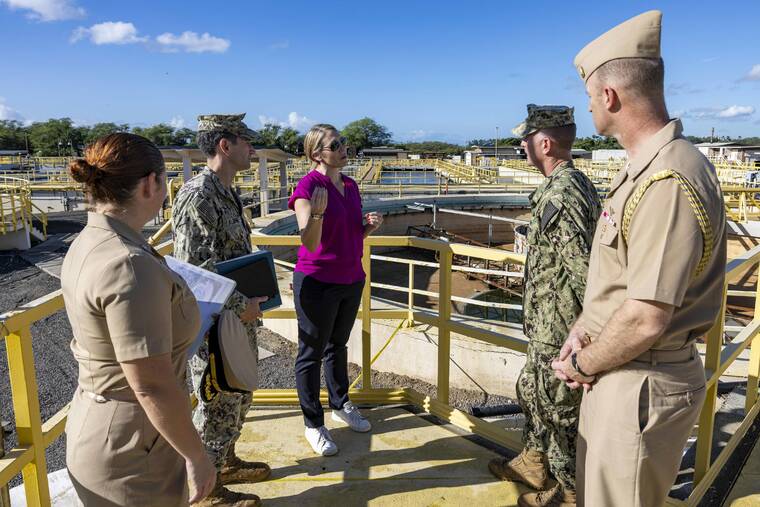The Navy this week reported accidental discharges of partially treated wastewater from its troubled wastewater treatment plant at Joint Base Pearl Harbor-
Hickam.
In separate news releases, the Navy reported that a total of 14,500 gallons was discharged Sunday and Monday into Mamala Bay through an outfall the service uses about 1.5 miles from shore.
According to a news release Tuesday on the most recent releases, there are two active projects at the plant tied to a Federal Facilities Compliance Agreement and that to “enable the execution of these projects, the plant is required to perform adjustments which will include a series of deliberate outages, to include partial shutdowns, at the (plant). The team is developing mitigation for future releases but expects the event to occur again tonight.”
According to a Monday news release, 9,500 gallons of partially treated wastewater was discharged at around 6 p.m. Sunday as a result of an apparent pump failure that caused the water to bypass the sand filter stage in the facility’s four-step process.
“The wastewater underwent three steps of a four step process,” JBPHH commander Capt. Mark Sohaney said in a statement. “The partially treated wastewater was discharged a mile and a half from the shore, therefore, there should be no
impact to beaches or nearshore waters along the Joint Base Pearl Harbor-Hickam shoreline.”
On Monday, also at 6 p.m., 5,000 gallons of partially treated wastewater again bypassed the filtration system, according to the Navy. “Unlike the previous night, the discharge was not the result of a pump failure,” a Tuesday news release said.
“The initial assessment
attributes the bypass to a higher-than-average flow at the plant. The Navy’s investigation attributes this higher flow rate to the King Tide that is causing additional water to be introduced into the system.”
The Navy said plant modifications to support ongoing improvement projects were in progress and that Navy officials think that “impacted the plant’s capacity to handle higher than normal flow rates.” Officials added that additional mitigations are being put in place to ensure that higher-than-normal flow rates experienced during the cycle of exceptionally high tides do not cause another bypass.
The Navy also said prior water testing has shown in instances when a bypass
has occurred that the discharged water was still in compliance with the plant’s discharge permit.
A spokesperson for the state Department of Health said its Clean Water Branch is awaiting sampling results from Naval Facilities Engineering Systems Command to determine whether further action is required.
Concerns about the site go as far back as 2019 when officials from the Clean Water Branch tried to inspect the plant but reported they found it in such a state of disrepair that they did not believe they could safely complete the inspection.
Inspectors for the U.S.
Environmental Protection Agency and the Navy followed up and reported that the plant had cracked concrete tanks, warped and disconnected parts in its machinery and severely corroded equipment. The EPA found that the plant was well exceeding its discharge limits for zinc, cadmium, oil and grease, and pH and total waste toxicity under the federal Clean Water Act.
In June 2021 the Navy entered a Federal Facilities Compliance Agreement with the EPA that required it to make a series of repairs and upgrades to the facility by the end of 2024.
In September the DOH slapped the Navy with a notice of violation and order that included an $8.7 million fine over repeated spills and maintenance problems with its wastewater system. DOH cited 766 counts of discharging pollutants into the ocean from January 2020 to July 2022; 212 counts related to operation and maintenance failures; and 17 counts of
bypassing filters without
authorization.
The violation order said the Navy exceeded the limit every day in 2020 as well as 276 days in 2021 and 122 days in 2022.
Just two days after the DOH issued the fine, another wastewater spill of 1,000 gallons poured into Pearl Harbor from a broken 12-inch wastewater line. Utility workers secured the leak and installed a plug, but the Navy said the leaked wastewater was “unrecoverable.”
In March approximately 14,000 gallons of partially treated wastewater was released from the facility after a power spike at the military base caused the water treatment process to be “interrupted for a few minutes.”

